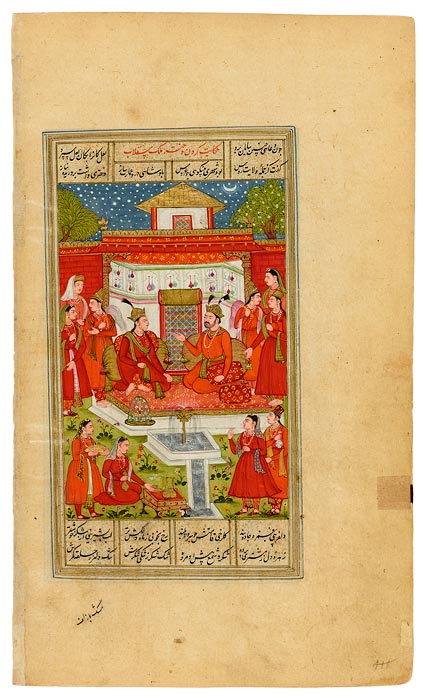
This episode appears in the Haft Paikar (Seven Princesses), the last part (1197) of the Persian poet Niẓāmī's Khamsa (Quintet). It is essentially a romanticized biography of Bahrām Gūr, a Persian king (r. 421–438) and a renowned hunter and lover.
On Tuesday, the day of Mars, dressed in red, Bahrām Gūr visits the Red Pavilion. Bahrām, whose name is the Persian term for "Mars," is in his own domain as Nasrīnnosh tells her story.
In Russia there lived a princess so beautiful and learned that she was unable to find an equal. She agreed to accept a suitor who was of noble descent, able to disarm the talismans, find entry to her fortress, and solve four riddles. Those who failed were beheaded. One young suitor, however, with the help of an old man, won the prize and thereafter dressed in red.
The story became the prototype for Puccini's opera, Turandot, a popular name for girls in the Near East.
This episode appears in the Haft Paikar (Seven Princesses), the last part (1197) of the Persian poet Niẓāmī's Khamsa (Quintet). It is essentially a romanticized biography of Bahrām Gūr, a Persian king (r. 421–438) and a renowned hunter and lover.
On Tuesday, the day of Mars, dressed in red, Bahrām Gūr visits the Red Pavilion. Bahrām, whose name is the Persian term for "Mars," is in his own domain as Nasrīnnosh tells her story.
In Russia there lived a princess so beautiful and learned that she was unable to find an equal. She agreed to accept a suitor who was of noble descent, able to disarm the talismans, find entry to her fortress, and solve four riddles. Those who failed were beheaded. One young suitor, however, with the help of an old man, won the prize and thereafter dressed in red.
The story became the prototype for Puccini's opera, Turandot, a popular name for girls in the Near East.
